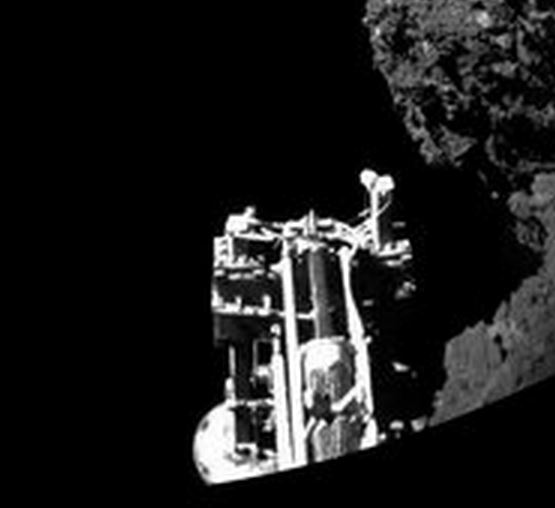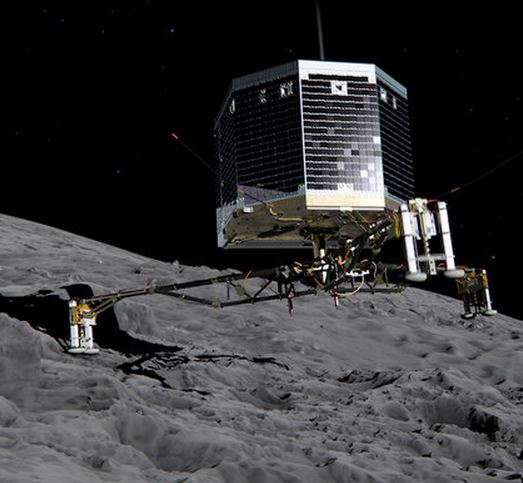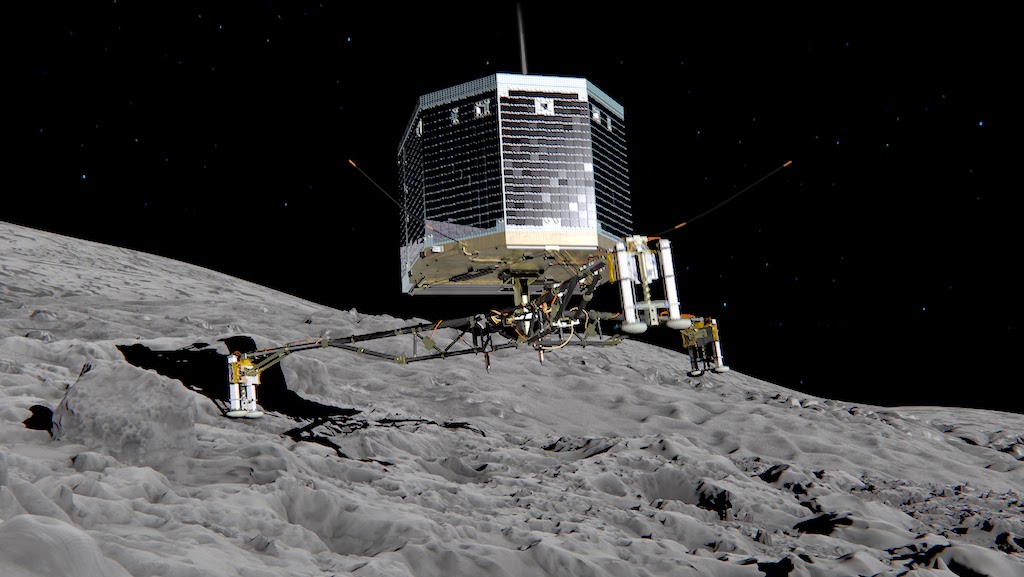The Rosetta spacecraft has seven more days of sending signals to the Philae robot lander to determine whether it is still alive. After March 20th, it will be out of the necessary orbit and won’t be aligned properly anymore.
Since making a bouncy landing on comet 67P/Churyumov-Gerasimenko in November and ending up on the dark side of a crater, Philae’s batteries have remained flat because its solar panels have not been able to absorb energy-filled sun rays.
No battery juice means the robot lander has not been able to make contact with orbiting Rosetta, which relays signals to Earth. In other words, we don’t know whether Philae is has been in hibernation or is just dead.

Rosetta took this picture of one of Philae’s three feet on March 13th. So we know it is safely on the surface of the comet. (Image: ESA)
Due to the comet’s gradual rotation, Philae is now on its sunny side. Scientists hope some of the sun’s rays are getting into the shadowy areas of the crater and hitting the robot’s solar panels so that its batteries can charge up and it can send a signal to Rosetta, which is currently directly aligned with it.
Scientists at the European Space Agency are eagerly waiting with the fingers crossed, hoping for a signal.
Koen Guerts, who heads the technical team, said “We don’t think we’ll hear anything just yet, but we cannot be very sure.”
Philae’s Project Manager, Stephan Ulamec, from the German Aerospace Center, said:
“Philae currently receives about twice as much solar energy as it did in November last year.”
Philae and its mothership Rosetta are currently 198 million miles (320m km) from the Sun.
Mr. Ulamec added:
“It will probably still be too cold for the lander to wake up, but it is worth trying. The prospects will improve with each passing day.”

Image of Comet 67P/Churyumov-Gerasimenko taken from Rosetta’s navigation camera on March 9th from a distance of 71.9 km. (Image: ESA)
Some things went wrong during landing
The original plan was for Philae to gently land on the comet’s sunny side, start analyzing its composition and send data back to Earth via Rosetta.
On November 11th, one of final tests before detachment from Rosetta revealed that Philae’s cold-gas thruster was not working properly. However, as it could not be repaired a “Go” was given anyway. The lander detached from Rosetta the following day.
Unfortunately, when Philae landed on comet 67P/Churyumov-Gerasimenko it bounced for two hours and ended up in a shaded part of a crater, meaning its solar panels could not charge up the batteries.
The robot managed to deploy its instruments successfully before its batteries went flat. It’s ice pick drill and hammer, which are designed to collect samples and analyze them, are ready to use.
Scientists at the European Space Agency say they want to find out whether comets might contain water and complex organic compounds. If they do, there is a chance they might have brought the building blocks of life to Earth many millions of years ago.

The Philae lander, if it has woken up and is operational again, will send us vital data on the composition of the comet. (Image: ESA)
How have low temperatures affected Philae?
Dr. Jean-Pierre Bibring (IAS, Orsay, France), lead lander scientist, said:
“The largest uncertainty though is whether Philae’s internal systems have suffered from the terribly low temperatures of the environment. Is the daily solar input on Philae sufficient to have enabled its survival to operate again?”
Before Philae can become operational again and scientists can put it to work, it needs to wake up from its winter hibernation. For that to occur, its interior must be at least -45ºC (or warmer).
Very little sunlight is reaching the lander, and temperatures where it is are much lower than originally planned.
Its solar panels need to generate at least 5.5 watts for Philae to wake up. The scientists believe it “has not remained idle during hibernation.”
When it has more then 5.5 watts of power and its internal temperature is -45ºC or warmer, it will ‘wake up’, heat up further, and try to charge up its battery.
Philae may already be awake
On waking up, Philae is programmed to activate its receiver every thirty minutes and listen for signals from Rosetta. Not much power is needed for it to do this.
Mr. Geurts said:
“At this time, we do not yet know that the lander is awake. To send us an answer, Philae must also turn its transmitter – and that requires additional power.”
Scientists say that Philae may already be awake, but does not yet have enough power to tell Rosetta. It needs at least 19 watts to operate and allow two-way communication with Rosetta.
Rosetta will only be receptive to a possible Philae signal until March 20th.
ESA said:
“The most likely time for contact is during the 11 flybys where the orbiter’s path puts it in a particularly favourable position with respect to the lander during comet ‘daytime’ – when Philae is in sunlight and being supplied with power by its solar panels.”
“Communication will be attempted continuously because Philae’s environment could have changed since landing in November 2014.”
ESA Video – A Comet Landing

